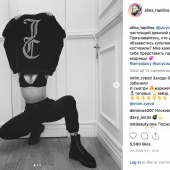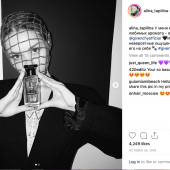
Alina Tapilina has it all. She's an influencer, who sells out to as many brands as she can, peppering her Instagram feed with carfeully staged photos that hawk various brands while trying to make her look like an authentic person living a fabulous lifestyle.
Alina's just lost one brand, thanks to Reuters.
Cigarette maker Philip Morris International Inc has suspended a global social media marketing campaign in response to Reuters inquiries into the company’s use of young online personalities to sell its new “heated tobacco” device, including a 21-year-old woman in Russia.
So how come someone who is old enough to use tobacco can't sell tobacco? Is it illegal? No, at least not in most countries. This comes as a result of Philip Morris's internal standards of marketing which stipulate any youth-oriented marketing has to be done by a person who is 25 years of age.
“We have taken the decision to suspend all of our product-related digital influencer actions globally,” the company told Reuters. “Whilst the influencer in question is a legal age adult smoker, she is under 25 and our guidance called for influencers to be 25+ years of age. This was a clear breach of that guidance.” “No laws were broken,” the company told Reuters. “However, we set high standards for ourselves and these facts do not excuse our failure to meet those standards in this instance.” The company added: “We were deeply disappointed to discover this breach and are grateful that it was brought to our attention.”
A smoking manufacturer doing something devious? Color me shocked. Anyone old enough to remember cigarette manufacturer R.J. Reynolds "Joe Camel," featuring a cartoon camel that consumer watchdogs felt was making smoking attractive to children knows this is their m.o. You have to get new customers somehow. And with the advent of heated-tobacco devices there's a whole crop of millennials ready to inhale. But in the great scheme of things, a cigarette manufacturer using an adult to advertise their brand in Russia is hardly Joe Camel. Even if influencers put their age in their bios, it's no guarantee that's truth, anyway. As Reuters points out, most of the influencers hired by Philip Morris don't list their ages and that "a Reuters review of the firm’s social media marketing of IQOS in Japan, Italy, Switzerland, Russia and Romania shows that Tapilina’s online persona was typical of what the company called its social media “ambassadors” for the device - rail-thin young women who revel in the high life." Not sure why Reuters had to body-shame to make their point, but while they are busy doing these hot exposés on a company not breaking the law but breaching its own self-policing rules, one might ask why Reuters hasn't discovered a much larger issue. Namely, some vape companies are not only making questionable advertisements and packaging that mimic children's products but infringing on intellectual property as well.


This mishap brings up some other questions we should be asking. Why are we still using influencers for anything? On a platform where likes and followers can be purchased, there's no way of knowing how much of the reach is real. Whether you're the the brand trying to sell something or the personal brand selling out, you get what you pay for. Sometimes you get the influencers controversy as they try to be edgy.
Here's another question: Is a world where some people have taken the "everyone is a brand," to such an extreme that they spend most of their day and night "selling," something the kind of world we want to live in? the answer hopefully, is no. In an excellent article for QZ, entitled "The age of the influencer has peaked It's time for the slacker to rise again," Rosie Spinks lays out an interesting argument that marks the divide between Millennials and Generation X. Some (not all) members of the former group have attempted to monetize their very existence. Whereas those in Generation X would have rather faded into obscurity than be caught "selling out." Spinks writes:
The internet influencer is the apotheosis of all this striving, this modern set of values taken to its grotesque extreme: Nothing is sacred, art has been replaced by “content,” and everything is for sale. This is true even when the message is swathed in the language of counter-culture: Eco-conscious influencers see no issue in flying long-haul on free trips from brands. Yoga gurus who traffic in anti-consumerist spirituality promote tea brands owned by Unilever.
As a result, there seems to be what Spinks calls "Influencer schadenfreude" among Generation Z. To them, living out loud constantly, is a bore. They aren't in it for the swag, the dopamine hit that comes from likes, or the paltry compensation, thank God.
That last part is crucial. We live in the gig economy side-hustle time. Despite the spin, this isn't some revolution for the small business owner or personal brand but a sad by-product. You have to hustle all the time just to make ends meet, never mind attain a lifestyle you pretend to live on Instagram. For every Kardashian, there are literally scores of influencers who don't make enough to have a career. They might not be thinking about a career, or whether they want one, but to grow up in a time without that option must be stressful.
For brands to cash in on their hunger for fame (or rather, save cash on it) is cynicism as its worst. Why pay a celebrity six figures to be on a billboard when you can give an influencer a tenth of that and some free product? And the advertising industry helped sell this idea through in its ever increasing race to the bottom.
The next time a client is convinced they want to go this route, I'm going to show her Alina Tapilina's Instagram feed. With the amount of brands she “sells,” they will end up just one in a sea of instantly liked, and instantly forgotten "content."



That Candy King vape logo is such direct copy of sour patch kids I'm surprised they haven't been sued.
- reply
Permalink